4 July 2025
Weekly Market View
Tax cuts and trade deals
If the first half of 2025 was marked by President Trump’s trade war, the second half is likely to be signposted by US tax cuts, trade deals and business deregulation. Fed rate cuts are likely to follow.
The passage of the US budget, which includes USD 4.5tn of tax cuts, and trade deals with key US partners will help reduce uncertainty and counter slowing growth. However, rising fiscal deficit and debt are likely to keep the USD under pressure.
While a near-term technical USD bounce is likely, we would use any such bounce to diversify into non-US equities and Emerging Market local currency bonds.
We remain bullish on US banks amid expectations of higher dividends after passing the Fed’s stress tests, expected relaxation of capital requirements and further deregulation of the sector.
We close our bullish US software sector equities idea with a 7.1% gain
Bullish US banks: Relaxation of bank capital, deregulation
Bullish EM local currency bonds: EM rate cuts, weak USD sustaining flows into EMs
Rangebound EUR/USD: ECB pushback against EUR strength vs USD weakness
Charts of the week: A stimulative budget
The US budget is estimated to increase the fiscal deficit by USD 3.4tn over ten years; the USD is due a near-term bounce
Net effect on US fiscal deficit from next year’s budget
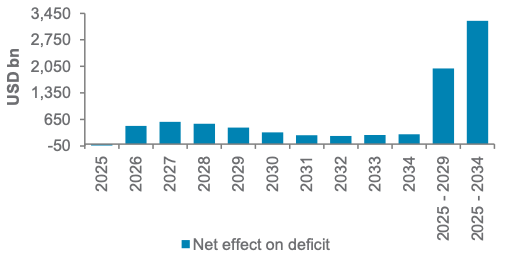
USD index (DXY) and combined investor positioning
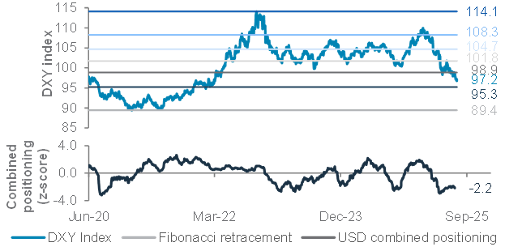
Source: US Congressional Budget Office, Bloomberg, Vanda Research, Standard Chartered
Editorial
Tax cuts and trade deals
Investment Strategy: If the first half of 2025 was marked by Trump’s trade war, the second half is likely to be signposted by US tax cuts, trade deals and business deregulation. Fed rate cuts are likely to follow. The passage of the US budget, which includes USD 4.5tn of tax cuts, and trade deals with key US partners will help reduce uncertainty and counter slowing growth. However, rising fiscal deficit and debt are likely to keep the USD under pressure. While a near-term technical USD bounce is likely, we would use any such bounce to diversify into non-US equities and Emerging Market local currency bonds.
Slowing growth: After four years of fiscally fuelled economic expansion following the pandemic, US growth is slowing as policy and trade uncertainty and high interest rates weigh on outlook. Following months of weak confidence indicators (“soft” data), the so-called “hard” data has started to weaken. Although headline net new non-farm payrolls rose unexpectedly in June, gains were mainly driven by government jobs. Private payroll gains fell to the lowest since October last year. Continuing jobless claims, which have jumped since Trump launched his trade war in April, are at their highest since 2021. A slowing job market is slowing consumption, the main driver of the economy. US real personal spending contracted 0.3% m/m in May. The housing market and private investment remain weak.
Tax cuts: The US budget for the fiscal year starting 1 October should help counter slowing growth. The budget is estimated to provide a USD 3.4tn fiscal boost to the USD 30tn economy over ten years. It includes USD 4.5tn of tax cuts (including extension of Trump’s 2017 tax cuts and new tax breaks for businesses and on tips, overtime pay, auto loans among others. It also makes USD 1.1tn of spending cuts. The latter includes cuts to healthcare, food and clean energy incentives. The net positive fiscal impact should more than offset the negative impact of tariffs on growth. The budget also raised the US debt ceiling by USD 5tn, helping the US avoid the risk of a near-term default.
Fed cuts to follow? The fiscal stimulus is likely to be followed by monetary stimulus. Slowing growth is building the case for the Fed to resume rate cuts after a pause since last year. The surprisingly resilient jobs report in June led money markets to price out any chance of a rate cut in July. However, markets are pricing 52bps of rate cuts by the end of the year, with 70% chance of a rate cut in September, and a terminal rate of around 3.1% by the end of 2026. Although Fed Chair Powell reiterated that rates need to be on hold until the impact of tariff on inflation is clearer, other Fed governors have made the case for a rate cut in July. A deterioration in the job market would hasten cuts.
Use any USD bounce to diversify: The USD index (DXY) has slumped to a three-year low. We expect the USD to remain weak on a 6-12-month horizon amid concerns about rising US debt and expectations of Fed rate cuts. However, technical and positioning indicators suggest the USD is oversold, raising the risk of a near-term technical bounce. Any short-term bounce, potentially with the conclusion of trade deals, can be used as an opportunity to diversify into non-US equity markets, especially in Asia-ex-Japan, and into EM local currency bonds.
Trade deals key to watch next week: Meanwhile, trade deals with key partners in the coming weeks (if not before Trump’s self-imposed 9 July deadline) will reduce a major market uncertainty. So far, the US has reached broad framework trade agreements with the UK, China and Vietnam. Agreements with India, South Korea and the European Union are likely to be reached shortly. A deal with Japan could take longer, especially with political sensitivities around core issues of auto exports and rice imports ahead of the Upper House election on 20 July.
While the UK deal sets a 10% baseline tariff for most partners, Vietnam agreed to a 20% tariff on all exports to the US and 40% tariff on goods transhipped through the economy. It’s unclear whether other transhipment hubs used by China in recent years, especially in Asia, will face similar tariffs. China’s reaction to the transhipment tariffs will also be watched closely.
The weekly macro balance sheet
Our weekly net assessment: On balance, we see the past week’s data and policy as positive for risk assets in the near-term
(+) factors: US job creation beat estimates; improving manufacturing activity in US and China; US Congress’s approval of tax-cutting budget
(-) factors: US inflation pressures; weaker Euro area economic confidence, China services sector
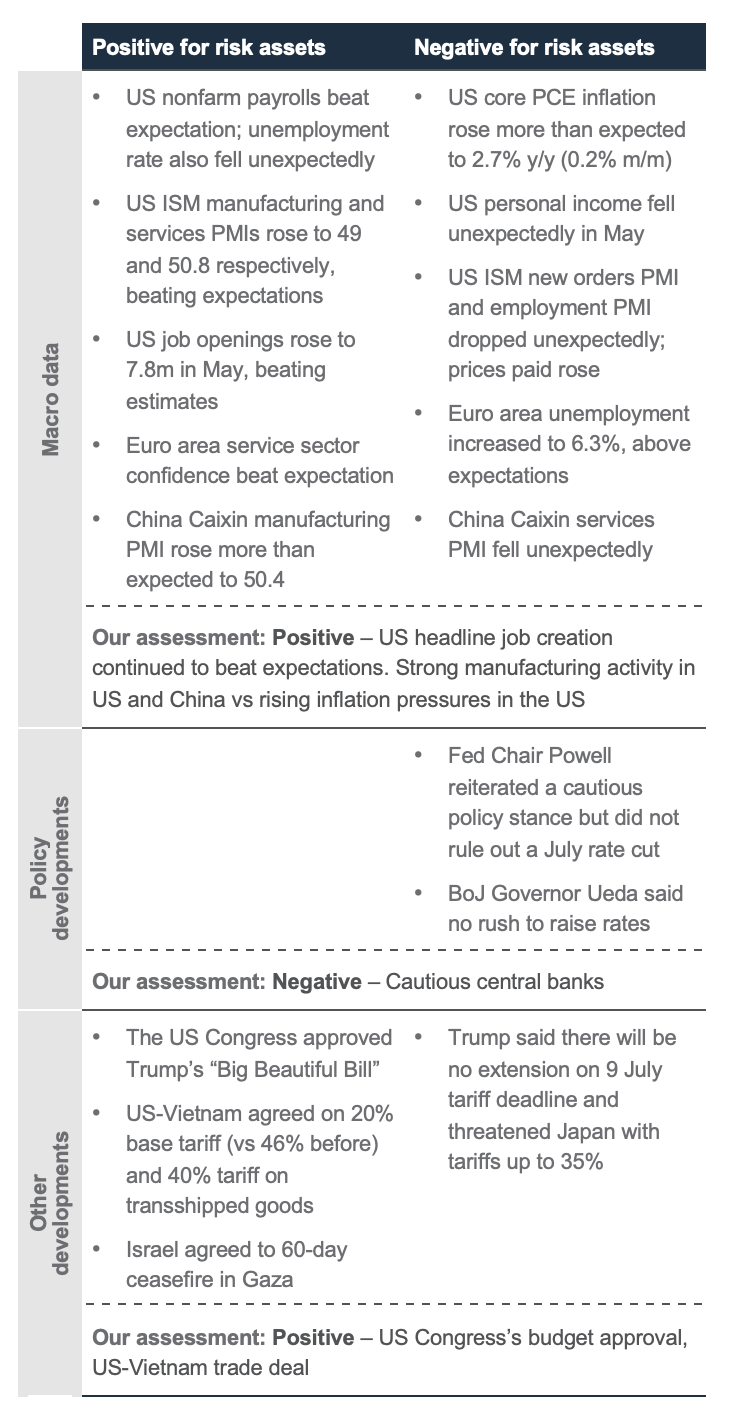
The US job market showed mixed signals. Non-farm payrolls in June beat expectations, but continuing jobless claims beat estimates
US non-farm payrolls, continuing jobless claims
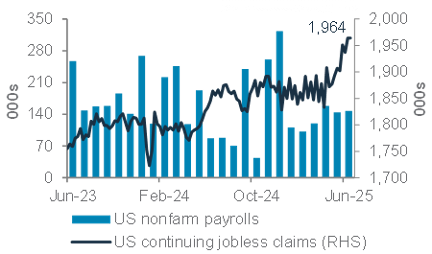
Euro area core inflation rose more than expected in May, while headline inflation was unchangedEuro area core and headline inflation
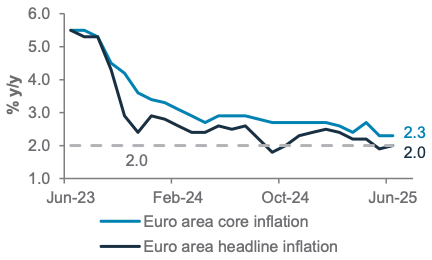
China’s Caixin manufacturing PMI fell below the neutral 50.0 mark for the first time in eight months. Services PMI was slightly above expectationsChina Caixin manufacturing and service PMIs
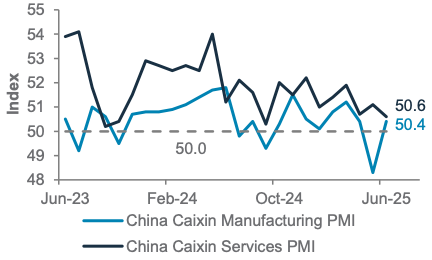
Top client questions
What is the outlook for US equities?
Our view: We view US equities as a Core Holding. Take advantage of the current strength and rotate excessive exposure to 1) non-US equity markets, and 2) major US banks.
Rationale: The S&P 500 index is at a new record high. Subsiding risks in the Middle East as well as the passing of the “Big Beautiful Bill” (“BBB”) have been driving US equities higher. Investor positioning on US equities is still light relative to history, at -0.4 standard deviation below Neutral levels, according to Vanda Research data. Historically, the current level of positioning indicates a 3-month forward return of approximately 4%.
That said, we see near-term headwinds. Valuations are expensive – 12m forward P/E for the MSCI US index is at 22.5x – almost 2 standard deviations above its historical average. Sustained earnings growth is needed to justify this valuation premium. The Q2 earnings season kicks off in two weeks’ time. Markets are currently projecting earnings growth of 5.8% y/y for the quarter, revised lower from 12% at the start of 2025 (source: LSEG I/B/E/S). This reflects geopolitical and tariff uncertainty, and their potential impact on supply chains and profit margins. “Soft data” remains under pressure, including consumer confidence, and there is uncertainty around whether US trade negotiations will extend beyond the 9 July deadline. All this means US equities face pullback risk at these elevated levels. Support is at 6,147, followed by 5,969.
We view US equities as a Core Holding. We suggest taking advantage of the current strength to trim excessive long exposure and add to other regional markets with strong domestic policy support and earnings growth projections, such as China and Korea within Asia. The removal of Section 899 from the final version of the US budget eliminates concerns about retaliatory taxes, which supports markets such as Euro area and Japan.
Within the US, we expect rotation into the major US banks. The sector is riding on expectations of a relaxation by the Fed in the “enhanced supplementary leverage ratio” for banks and the passing of the Fed’s annual stress tests. We expect further deregulation to help support US banking sector equities.
— Michelle Kam, CFA, Investment Strategist
Consensus earnings growth estimates for US equities in Q2 have been revised lower since the start of the year
Consensus earnings growth estimates for S&P 500 index in Q2’25 and FY25, in 3 July vs. 1 January
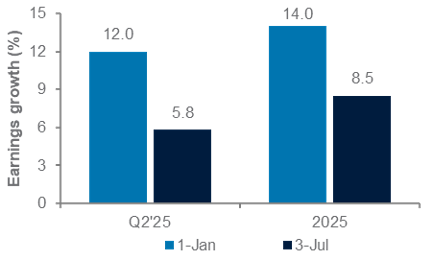
The S&P 500 Banks index is still trading at a discount to the S&P 500 index
Relative P/E ratio of S&P 500 banks / S&P 500 indices
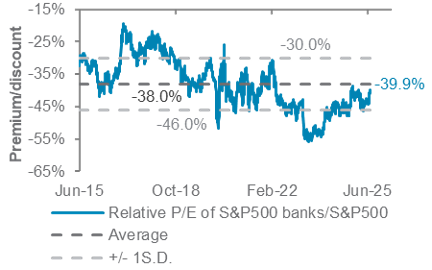
The US 10-year government bond yield has been on a downtrend since the end of May. Where do you see opportunities in bond markets?
Our view: Add to Emerging Market (EM) local currency (LCY) government bonds on pullbacks. EM LCY government bonds currently yield over 5.9%, at the higher end of their 5-year range.
Rationale: The US 10-year government bond yield fell to the 4-4.25% range earlier this week. However, the yield subsequently rebounded above 4.25% after the surprisingly strong US payrolls report. The still-resilient US job market and the upcoming US trade negotiations (and associated tensions) argues for higher yields. This is until slower growth allows the Fed to cut interest rates from September, driving a renewed move lower in the 10-year yield.
Meanwhile, many EM economies have strengthened their fiscal and current accounts in recent years. Their benign inflation outlook, bolstered by the expected reduction in US interest rates and a weak USD, have resulted in high real yields (nominal yield minus inflation). These factors should enable EM central banks to cut interest rates. This, together with our weak USD view, is why we are Overweight EM LCY bonds.
We are also opportunistically bullish on EM Asia local currency bonds. A weaker USD is likely to attract increased fund flows into the asset class, which offers diversification benefits due to its low-to-moderate correlation with major developed market bonds.
Risks to our view include EM’s susceptibility to market volatility and geopolitical uncertainties. Weaker US demand and higher tariffs could also pose challenges to these economies.
— Ray Heung, Senior Investment Strategist
The yield on EM local currency government bonds is attractive from a historical perspective
EM Local Currency Government Bond Index yield
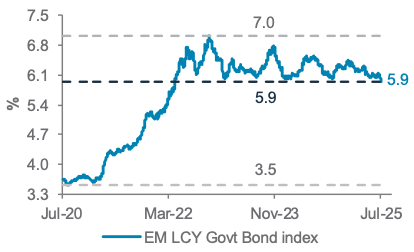
Why have you closed your US software equities opportunistic idea?
Our view: We close our US technology software opportunistic idea as the potential reward no longer compensates for the risk.
Rationale: We close our idea at a 7.1% profit since inception on 20 February, 25. The index heavyweights have been weakening technically, and the index is susceptible to pullback after breaking all-time high. US software stocks are now closer to fair value, beingslightly more expensive than their 5-year average price-to-earnings ratio. Within US equities, the focus is moving to the major US banks, with deregulation as a key narrative in the near-term.
— Daniel Lam, Head, Equity Strategy
The US software index is now closer to fair value
P/E ratio for the S&P North American Expanded Technology Software Index
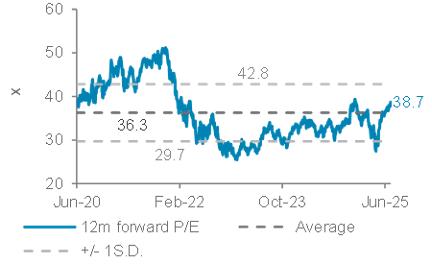
Top client questions (cont’d)
EUR/USD is trading close to a four-year high. What is your view on the pair?
Our View: EUR/USD to be rangebound with risk of short-term pullback. Resistance near 1.20, while support is at 1.14.
Rationale: The EUR has gained over 10% against the US dollar this year, prompting concerns amongst ECB officials that further appreciation could undermine the central bank’s 2% inflation target and economic recovery. A move in EUR/USD above 1.20 is expected to trigger stronger ECB pushback, including verbal intervention or further rate cuts, to counter disinflationary pressures.
Our long-term weak USD bias notwithstanding, EUR/USD is currently overbought and, thus, is technically challenged. The pair has been grinding higher, while its relative strength indicator (RSI) is diminishing in strength, suggesting waning momentum and therefore limited room for further upside. We expect a partial unwind of stretched bearish USD positions. This dynamic supports a range-bounding EUR/USD, between 1.14 to 1.20.
— Iris Yuen, Investment Strategist
Play the EUR/USD trading range. We anticipate a short-term pullback in the pair due to excessive bearish positions in the USD
EUR/USD and its expected range
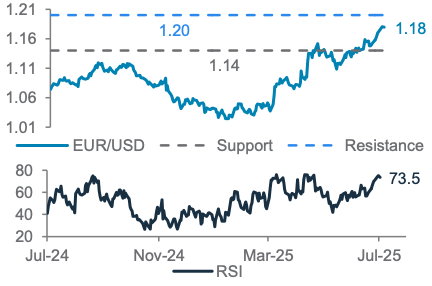
What is your view on Korea equities following the passing of the Commercial Act amendments by the National Assembly?
Action: We are Overweight Korean equities within Asia ex-Japan. We expect further policy support from the Korean government, alongside appealing valuations and a weak USD, to support further market growth.
Rationale: South Korea’s parliament passed the Commercial Act amendment on 3 July, with proposals such as: 1) expanding directors’ fiduciary duties, 2) mandating the adoption of electronic general meetings, and 3) enhancing the application of “3% rule”. The revision to the Act is expected to protect minority shareholders’ interests and support corporates’ valuations.
Markets reacted favourably following the passing of the Act, with the KOSPI index closing 1.3% higher on the day. We see near-term market sentiment to be clouded by 1) heightened tariff concerns as the 9 July US trade deadline approaches, and 2) potential delay in BoK’s policy pivot due to a pick-up in inflation, we are bullish Korea equities over a 12-month horizon. However, 1) valuation is cheap. Korea equities trade at a 28% discount to Asia ex-Japan equities, despite a strong rally since April, 2) further fiscal expansion plans under President Lee’s administration, such as the revamp of the tax system, 3) improving corporate governance, and 4) the weak USD and the historically inverse correlation between USD and Asia market performances. This can stimulate the region’s earnings growth projections and ultimately narrow the valuation discount.
— Michelle Kam, CFA, Investment Strategist
Korean equities are trading at a significant discount to Asia ex-Japan equities
Relative 12-month forward P/E for MSCI Korea vs. MSCI Asia ex-Japan index
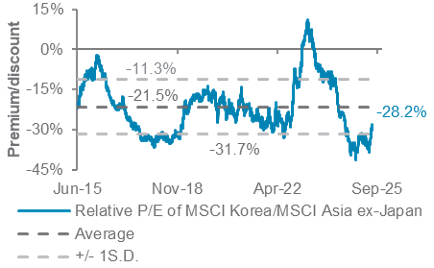
Market performance summary*
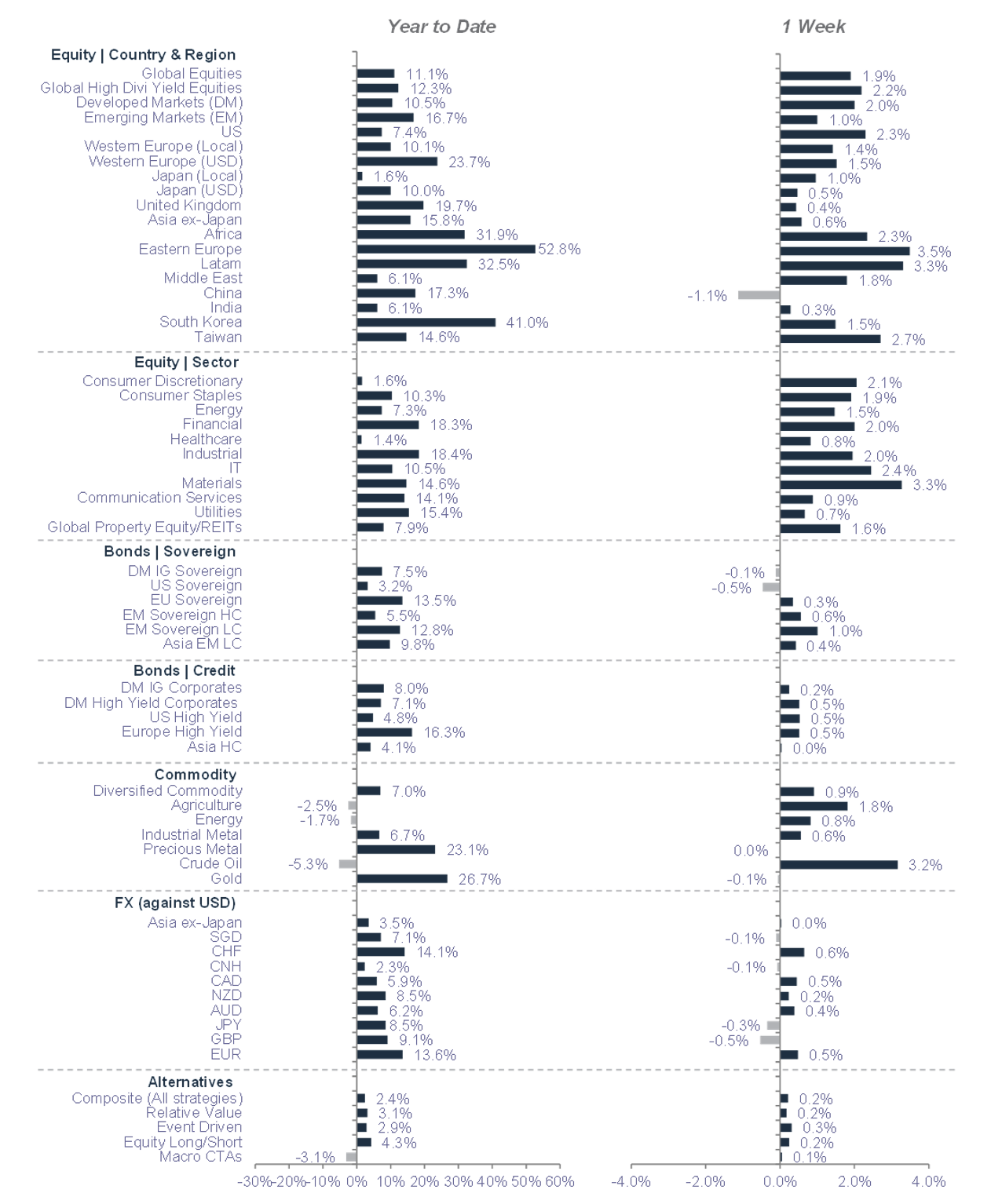
*Performance in USD terms unless otherwise stated, 2025 YTD performance from 31 December 2024 to 3 Jul 2025; 1-week period: 26 June 2025 to 3 Jul 2025
Our 12-month asset class views at a glance
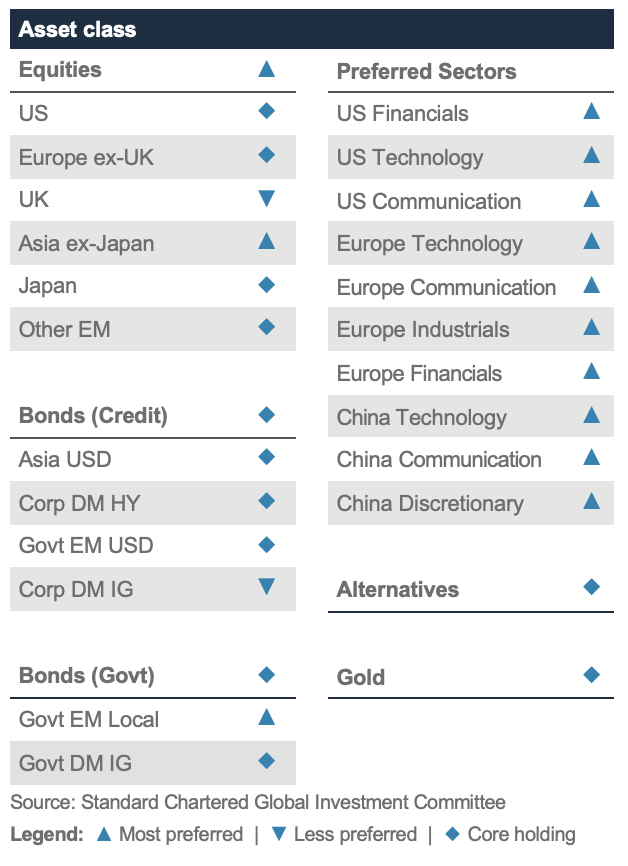
Economic and market calendar
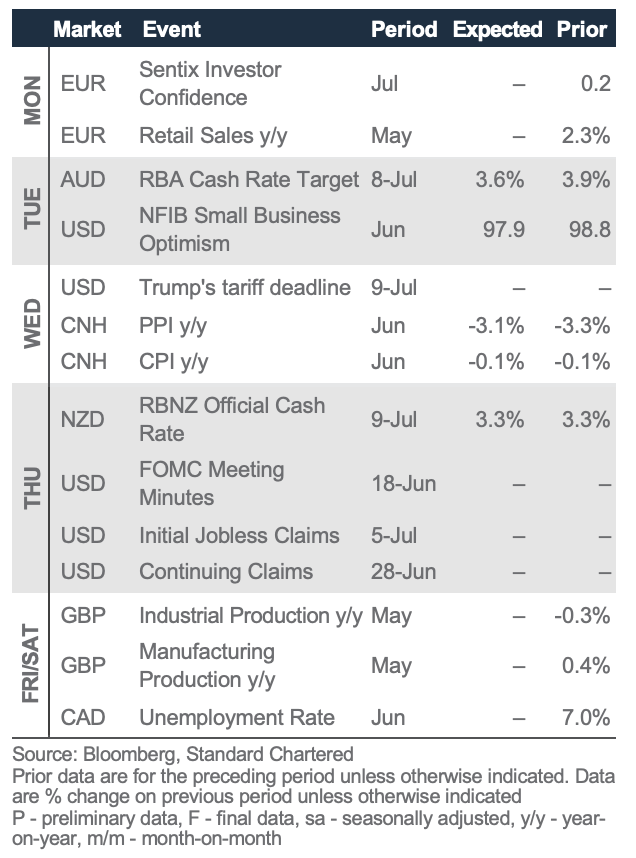
The S&P500 has next interim resistance at 6,402
Technical indicators for key markets as of 3 July close
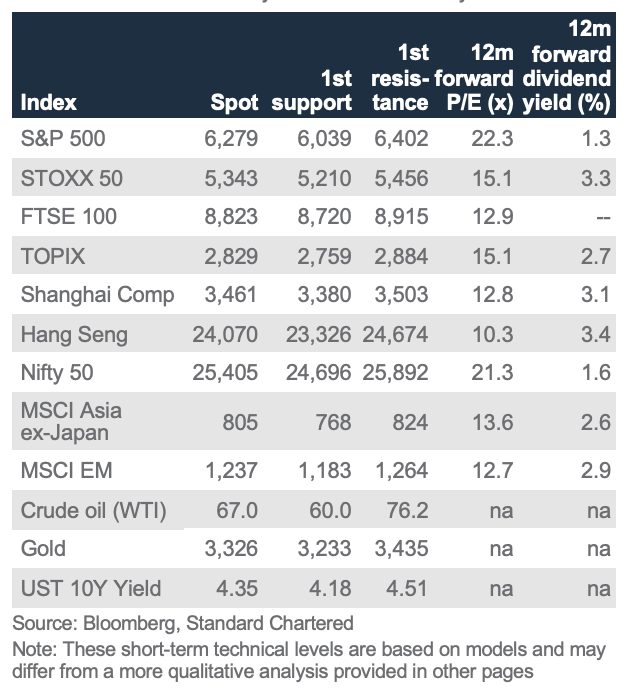
Investor diversity in EM Local bonds fell below threshold
Our proprietary market diversity indicators as of 3 July close
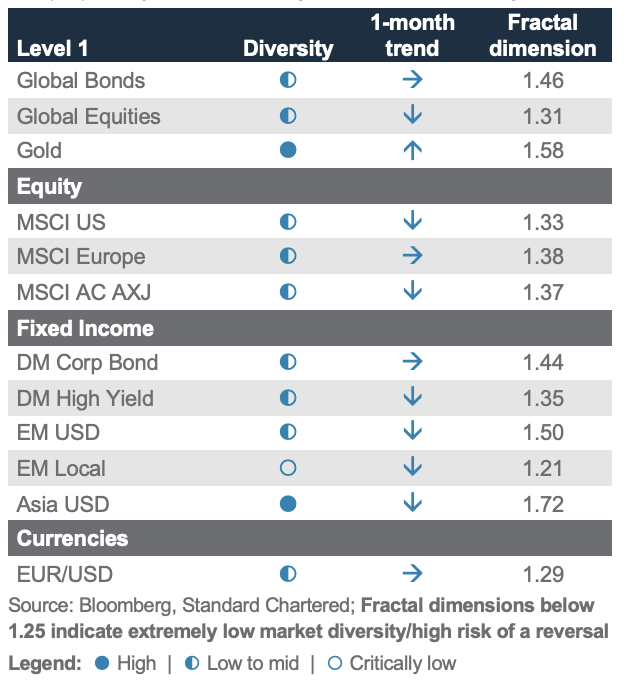

Disclosure
This document is confidential and may also be privileged. If you are not the intended recipient, please destroy all copies and notify the sender immediately. This document is being distributed for general information only and is subject to the relevant disclaimers available at our Standard Chartered website under Regulatory disclosures. It is not and does not constitute research material, independent research, an offer, recommendation or solicitation to enter into any transaction or adopt any hedging, trading or investment strategy, in relation to any securities or other financial instruments. This document is for general evaluation only. It does not take into account the specific investment objectives, financial situation or particular needs of any particular person or class of persons and it has not been prepared for any particular person or class of persons. You should not rely on any contents of this document in making any investment decisions. Before making any investment, you should carefully read the relevant offering documents and seek independent legal, tax and regulatory advice. In particular, we recommend you to seek advice regarding the suitability of the investment product, taking into account your specific investment objectives, financial situation or particular needs, before you make a commitment to purchase the investment product. Opinions, projections and estimates are solely those of SC at the date of this document and subject to change without notice. Past performance is not indicative of future results and no representation or warranty is made regarding future performance. The value of investments, and the income from them, can go down as well as up, and you may not recover the amount of your original investment. You are not certain to make a profit and may lose money. Any forecast contained herein as to likely future movements in rates or prices or likely future events or occurrences constitutes an opinion only and is not indicative of actual future movements in rates or prices or actual future events or occurrences (as the case may be). This document must not be forwarded or otherwise made available to any other person without the express written consent of the Standard Chartered Group (as defined below). Standard Chartered Bank is incorporated in England with limited liability by Royal Charter 1853 Reference Number ZC18. The Principal Office of the Company is situated in England at 1 Basinghall Avenue, London, EC2V 5DD. Standard Chartered Bank is authorised by the Prudential Regulation Authority and regulated by the Financial Conduct Authority and Prudential Regulation Authority. Standard Chartered PLC, the ultimate parent company of Standard Chartered Bank, together with its subsidiaries and affiliates (including each branch or representative office), form the Standard Chartered Group. Standard Chartered Private Bank is the private banking division of Standard Chartered. Private banking activities may be carried out internationally by different legal entities and affiliates within the Standard Chartered Group (each an “SC Group Entity”) according to local regulatory requirements. Not all products and services are provided by all branches, subsidiaries and affiliates within the Standard Chartered Group. Some of the SC Group Entities only act as representatives of Standard Chartered Private Bank and may not be able to offer products and services or offer advice to clients.
Copyright © 2025, Accounting Research & Analytics, LLC d/b/a CFRA (and its affiliates, as applicable). Reproduction of content provided by CFRA in any form is prohibited except with the prior written permission of CFRA. CFRA content is not investment advice and a reference to or observation concerning a security or investment provided in the CFRA SERVICES is not a recommendation to buy, sell or hold such investment or security or make any other investment decisions. The CFRA content contains opinions of CFRA based upon publicly-available information that CFRA believes to be reliable and the opinions are subject to change without notice. This analysis has not been submitted to, nor received approval from, the United States Securities and Exchange Commission or any other regulatory body. While CFRA exercised due care in compiling this analysis, CFRA, ITS THIRD-PARTY SUPPLIERS, AND ALL RELATED ENTITIES SPECIFICALLY DISCLAIM ALL WARRANTIES, EXPRESS OR IMPLIED, INCLUDING, BUT NOT LIMITED TO, ANY WARRANTIES OF MERCHANTABILITY OR FITNESS FOR A PARTICULAR PURPOSE OR USE, to the full extent permitted by law, regarding the accuracy, completeness, or usefulness of this information and assumes no liability with respect to the consequences of relying on this information for investment or other purposes. No content provided by CFRA (including ratings, credit-related analyses and data, valuations, model, software or other application or output therefrom) or any part thereof may be modified, reverse engineered, reproduced or distributed in any form by any means, or stored in a database or retrieval system, without the prior written permission of CFRA, and such content shall not be used for any unlawful or unauthorized purposes. CFRA and any third-party providers, as well as their directors, officers, shareholders, employees or agents do not guarantee the accuracy, completeness, timeliness or availability of such content. In no event shall CFRA, its affiliates, or their third-party suppliers be liable for any direct, indirect, special, or consequential damages, costs, expenses, legal fees, or losses (including lost income or lost profit and opportunity costs) in connection with a subscriber’s, subscriber’s customer’s, or other’s use of CFRA’s content.
Market Abuse Regulation (MAR) Disclaimer
Banking activities may be carried out internationally by different branches, subsidiaries and affiliates within the Standard Chartered Group according to local regulatory requirements. Opinions may contain outright “buy”, “sell”, “hold” or other opinions. The time horizon of this opinion is dependent on prevailing market conditions and there is no planned frequency for updates to the opinion. This opinion is not independent of Standard Chartered Group’s trading strategies or positions. Standard Chartered Group and/or its affiliates or its respective officers, directors, employee benefit programmes or employees, including persons involved in the preparation or issuance of this document may at any time, to the extent permitted by applicable law and/or regulation, be long or short any securities or financial instruments referred to in this document or have material interest in any such securities or related investments. Therefore, it is possible, and you should assume, that Standard Chartered Group has a material interest in one or more of the financial instruments mentioned herein. Please refer to our Standard Chartered website under Regulatory disclosures for more detailed disclosures, including past opinions/ recommendations in the last 12 months and conflict of interests, as well as disclaimers. A covering strategist may have a financial interest in the debt or equity securities of this company/issuer. All covering strategist are licensed to provide investment recommendations under Monetary Authority of Singapore or Hong Kong Monetary Authority. This document must not be forwarded or otherwise made available to any other person without the express written consent of Standard Chartered Group.
Sustainable Investments
Any ESG data used or referred to has been provided by Morningstar, Sustainalytics, MSCI or Bloomberg. Refer to 1) Morningstar website under Sustainable Investing, 2) Sustainalytics website under ESG Risk Ratings, 3) MCSI website under ESG Business Involvement Screening Research and 4) Bloomberg green, social & sustainability bonds guide for more information. The ESG data is as at the date of publication based on data provided, is for informational purpose only and is not warranted to be complete, timely, accurate or suitable for a particular purpose, and it may be subject to change. Sustainable Investments (SI): This refers to funds that have been classified as ‘Sustainable Investments’ by Morningstar. SI funds have explicitly stated in their prospectus and regulatory filings that they either incorporate ESG factors into the investment process or have a thematic focus on the environment, gender diversity, low carbon, renewable energy, water or community development. For equity, it refers to shares/stocks issued by companies with Sustainalytics ESG Risk Rating of Low/Negligible. For bonds, it refers to debt instruments issued by issuers with Sustainalytics ESG Risk Rating of Low/Negligible, and/or those being certified green, social, sustainable bonds by Bloomberg. For structured products, it refers to products that are issued by any issuer who has a Sustainable Finance framework that aligns with Standard Chartered’s Green and Sustainable Product Framework, with underlying assets that are part of the Sustainable Investment universe or separately approved by Standard Chartered’s Sustainable Finance Governance Committee. Sustainalytics ESG risk ratings shown are factual and are not an indicator that the product is classified or marketed as “green”, “sustainable” or similar under any particular classification system or framework.
Country/Market Specific Disclosures
Botswana: This document is being distributed in Botswana by, and is attributable to, Standard Chartered Bank Botswana Limited which is a financial institution licensed under the Section 6 of the Banking Act CAP 46.04 and is listed in the Botswana Stock Exchange. Brunei Darussalam: This document is being distributed in Brunei Darussalam by, and is attributable to, Standard Chartered Bank (Brunei Branch) | Registration Number RFC/61 and Standard Chartered Securities (B) Sdn Bhd | Registration Number RC20001003. Standard Chartered Bank is incorporated in England with limited liability by Royal Charter 1853 Reference Number ZC18. Standard Chartered Securities (B) Sdn Bhd is a limited liability company registered with the Registry of Companies with Registration Number RC20001003 and licensed by Brunei Darussalam Central Bank as a Capital Markets Service License Holder with License Number BDCB/R/CMU/S3-CL and it is authorised to conduct Islamic investment business through an Islamic window. China Mainland: This document is being distributed in China by, and is attributable to, Standard Chartered Bank (China) Limited which is mainly regulated by National Financial Regulatory Administration (NFRA), State Administration of Foreign Exchange (SAFE), and People’s Bank of China (PBOC). Hong Kong: In Hong Kong, this document, except for any portion advising on or facilitating any decision on futures contracts trading, is distributed by Standard Chartered Bank (Hong Kong) Limited (“SCBHK”), a subsidiary of Standard Chartered PLC. SCBHK has its registered address at 32/F, Standard Chartered Bank Building, 4-4A Des Voeux Road Central, Hong Kong and is regulated by the Hong Kong Monetary Authority and registered with the Securities and Futures Commission (“SFC”) to carry on Type 1 (dealing in securities), Type 4 (advising on securities), Type 6 (advising on corporate finance) and Type 9 (asset management) regulated activity under the Securities and Futures Ordinance (Cap. 571) (“SFO”) (CE No. AJI614). The contents of this document have not been reviewed by any regulatory authority in Hong Kong and you are advised to exercise caution in relation to any offer set out herein. If you are in doubt about any of the contents of this document, you should obtain independent professional advice. Any product named herein may not be offered or sold in Hong Kong by means of any document at any time other than to “professional investors” as defined in the SFO and any rules made under that ordinance. In addition, this document may not be issued or possessed for the purposes of issue, whether in Hong Kong or elsewhere, and any interests may not be disposed of, to any person unless such person is outside Hong Kong or is a “professional investor” as defined in the SFO and any rules made under that ordinance, or as otherwise may be permitted by that ordinance. In Hong Kong, Standard Chartered Private Bank is the private banking division of SCBHK, a subsidiary of Standard Chartered PLC. Ghana: Standard Chartered Bank Ghana Limited accepts no liability and will not be liable for any loss or damage arising directly or indirectly (including special, incidental or consequential loss or damage) from your use of these documents. Past performance is not indicative of future results and no representation or warranty is made regarding future performance. You should seek advice from a financial adviser on the suitability of an investment for you, taking into account these factors before making a commitment to invest in an investment. To unsubscribe from receiving further updates, please send an email to feedback.ghana@sc.com. Please do not reply to this email. Call our Priority Banking on 0302610750 for any questions or service queries. You are advised not to send any confidential and/or important information to Standard Chartered via e-mail, as Standard Chartered makes no representations or warranties as to the security or accuracy of any information transmitted via e-mail. Standard Chartered shall not be responsible for any loss or damage suffered by you arising from your decision to use e-mail to communicate with the Bank. India: This document is being distributed in India by Standard Chartered in its capacity as a distributor of mutual funds and referrer of any other third party financial products. Standard Chartered does not offer any ‘Investment Advice’ as defined in the Securities and Exchange Board of India (Investment Advisers) Regulations, 2013 or otherwise. Services/products related securities business offered by Standard Charted are not intended for any person, who is a resident of any jurisdiction, the laws of which imposes prohibition on soliciting the securities business in that jurisdiction without going through the registration requirements and/or prohibit the use of any information contained in this document. Indonesia: This document is being distributed in Indonesia by Standard Chartered Bank, Indonesia branch, which is a financial institution licensed and supervised by Otoritas Jasa Keuangan (Financial Service Authority) and Bank Indonesia. Jersey: In Jersey, Standard Chartered Private Bank is the Registered Business Name of the Jersey Branch of Standard Chartered Bank. The Jersey Branch of Standard Chartered Bank is regulated by the Jersey Financial Services Commission. Copies of the latest audited accounts of Standard Chartered Bank are available from its principal place of business in Jersey: PO Box 80, 15 Castle Street, St Helier, Jersey JE4 8PT. Standard Chartered Bank is incorporated in England with limited liability by Royal Charter in 1853 Reference Number ZC 18. The Principal Office of the Company is situated in England at 1 Basinghall Avenue, London, EC2V 5DD. Standard Chartered Bank is authorised by the Prudential Regulation Authority and regulated by the Financial Conduct Authority and Prudential Regulation Authority. The Jersey Branch of Standard Chartered Bank is also an authorised financial services provider under license number 44946 issued by the Financial Sector Conduct Authority of the Republic of South Africa. Jersey is not part of the United Kingdom and all business transacted with Standard Chartered Bank, Jersey Branch and other SC Group Entity outside of the United Kingdom, are not subject to some or any of the investor protection and compensation schemes available under United Kingdom law. Kenya: This document is being distributed in Kenya by and is attributable to Standard Chartered Bank Kenya Limited. Investment Products and Services are distributed by Standard Chartered Investment Services Limited, a wholly owned subsidiary of Standard Chartered Bank Kenya Limited that is licensed by the Capital Markets Authority in Kenya, as a Fund Manager. Standard Chartered Bank Kenya Limited is regulated by the Central Bank of Kenya. Malaysia: This document is being distributed in Malaysia by Standard Chartered Bank Malaysia Berhad (“SCBMB”). Recipients in Malaysia should contact SCBMB in relation to any matters arising from, or in connection with, this document. This document has not been reviewed by the Securities Commission Malaysia. The product lodgement, registration, submission or approval by the Securities Commission of Malaysia does not amount to nor indicate recommendation or endorsement of the product, service or promotional activity. Investment products are not deposits and are not obligations of, not guaranteed by, and not protected by SCBMB or any of the affiliates or subsidiaries, or by Perbadanan Insurans Deposit Malaysia, any government or insurance agency. Investment products are subject to investment risks, including the possible loss of the principal amount invested. SCBMB expressly disclaim any liability and responsibility for any loss arising directly or indirectly (including special, incidental or consequential loss or damage) arising from the financial losses of the Investment Products due to market condition. Nigeria: This document is being distributed in Nigeria by Standard Chartered Bank Nigeria Limited (SCB Nigeria), a bank duly licensed and regulated by the Central Bank of Nigeria. SCB Nigeria accepts no liability for any loss or damage arising directly or indirectly (including special, incidental or consequential loss or damage) from your use of these documents. You should seek advice from a financial adviser on the suitability of an investment for you, taking into account these factors before making a commitment to invest in an investment. To unsubscribe from receiving further updates, please send an email to clientcare.ng@sc.com requesting to be removed from our mailing list. Please do not reply to this email. Call our Priority Banking on 02 012772514 for any questions or service queries. SCB Nigeria shall not be responsible for any loss or damage arising from your decision to send confidential and/or important information to Standard Chartered via e-mail. SCB Nigeria makes no representations or warranties as to the security or accuracy of any information transmitted via e-mail. Pakistan: This document is being distributed in Pakistan by, and attributable to Standard Chartered Bank (Pakistan) Limited having its registered office at PO Box 5556, I.I Chundrigar Road Karachi, which is a banking company registered with State Bank of Pakistan under Banking Companies Ordinance 1962 and is also having licensed issued by Securities & Exchange Commission of Pakistan for Security Advisors. Standard Chartered Bank (Pakistan) Limited acts as a distributor of mutual funds and referrer of other third-party financial products. Singapore: This document is being distributed in Singapore by, and is attributable to, Standard Chartered Bank (Singapore) Limited (Registration No. 201224747C/ GST Group Registration No. MR-8500053-0, “SCBSL”). Recipients in Singapore should contact SCBSL in relation to any matters arising from, or in connection with, this document. SCBSL is an indirect wholly owned subsidiary of Standard Chartered Bank and is licensed to conduct banking business in Singapore under the Singapore Banking Act, 1970. Standard Chartered Private Bank is the private banking division of SCBSL. IN RELATION TO ANY SECURITY OR SECURITIES-BASED DERIVATIVES CONTRACT REFERRED TO IN THIS DOCUMENT, THIS DOCUMENT, TOGETHER WITH THE ISSUER DOCUMENTATION, SHALL BE DEEMED AN INFORMATION MEMORANDUM (AS DEFINED IN SECTION 275 OF THE SECURITIES AND FUTURES ACT, 2001 (“SFA”)). THIS DOCUMENT IS INTENDED FOR DISTRIBUTION TO ACCREDITED INVESTORS, AS DEFINED IN SECTION 4A(1)(a) OF THE SFA, OR ON THE BASIS THAT THE SECURITY OR SECURITIES-BASED DERIVATIVES CONTRACT MAY ONLY BE ACQUIRED AT A CONSIDERATION OF NOT LESS THAN S$200,000 (OR ITS EQUIVALENT IN A FOREIGN CURRENCY) FOR EACH TRANSACTION. Further, in relation to any security or securities-based derivatives contract, neither this document nor the Issuer Documentation has been registered as a prospectus with the Monetary Authority of Singapore under the SFA. Accordingly, this document and any other document or material in connection with the offer or sale, or invitation for subscription or purchase, of the product may not be circulated or distributed, nor may the product be offered or sold, or be made the subject of an invitation for subscription or purchase, whether directly or indirectly, to persons other than a relevant person pursuant to section 275(1) of the SFA, or any person pursuant to section 275(1A) of the SFA, and in accordance with the conditions specified in section 275 of the SFA, or pursuant to, and in accordance with the conditions of, any other applicable provision of the SFA. In relation to any collective investment schemes referred to in this document, this document is for general information purposes only and is not an offering document or prospectus (as defined in the SFA). This document is not, nor is it intended to be (i) an offer or solicitation of an offer to buy or sell any capital markets product; or (ii) an advertisement of an offer or intended offer of any capital markets product. Deposit Insurance Scheme: Singapore dollar deposits of non-bank depositors are insured by the Singapore Deposit Insurance Corporation, for up to S$100,000 in aggregate per depositor per Scheme member by law. Foreign currency deposits, dual currency investments, structured deposits and other investment products are not insured. This advertisement has not been reviewed by the Monetary Authority of Singapore. Taiwan: SC Group Entity or Standard Chartered Bank (Taiwan) Limited (“SCB (Taiwan)”) may be involved in the financial instruments contained herein or other related financial instruments. The author of this document may have discussed the information contained herein with other employees or agents of SC or SCB (Taiwan). The author and the above-mentioned employees of SC or SCB (Taiwan) may have taken related actions in respect of the information involved (including communication with customers of SC or SCB (Taiwan) as to the information contained herein). The opinions contained in this document may change, or differ from the opinions of employees of SC or SCB (Taiwan). SC and SCB (Taiwan) will not provide any notice of any changes to or differences between the above-mentioned opinions. This document may cover companies with which SC or SCB (Taiwan) seeks to do business at times and issuers of financial instruments. Therefore, investors should understand that the information contained herein may serve as specific purposes as a result of conflict of interests of SC or SCB (Taiwan). SC, SCB (Taiwan), the employees (including those who have discussions with the author) or customers of SC or SCB (Taiwan) may have an interest in the products, related financial instruments or related derivative financial products contained herein; invest in those products at various prices and on different market conditions; have different or conflicting interests in those products. The potential impacts include market makers’ related activities, such as dealing, investment, acting as agents, or performing financial or consulting services in relation to any of the products referred to in this document. UAE: DIFC – Standard Chartered Bank is incorporated in England with limited liability by Royal Charter 1853 Reference Number ZC18.The Principal Office of the Company is situated in England at 1 Basinghall Avenue, London, EC2V 5DD. Standard Chartered Bank is authorised by the Prudential Regulation Authority and regulated by the Financial Conduct Authority and Prudential Regulation Authority. Standard Chartered Bank, Dubai International Financial Centre having its offices at Dubai International Financial Centre, Building 1, Gate Precinct, P.O. Box 999, Dubai, UAE is a branch of Standard Chartered Bank and is regulated by the Dubai Financial Services Authority (“DFSA”). This document is intended for use only by Professional Clients and is not directed at Retail Clients as defined by the DFSA Rulebook. In the DIFC we are authorised to provide financial services only to clients who qualify as Professional Clients and Market Counterparties and not to Retail Clients. As a Professional Client you will not be given the higher retail client protection and compensation rights and if you use your right to be classified as a Retail Client we will be unable to provide financial services and products to you as we do not hold the required license to undertake such activities. For Islamic transactions, we are acting under the supervision of our Shariah Supervisory Committee. Relevant information on our Shariah Supervisory Committee is currently available on the Standard Chartered Bank website in the Islamic banking section. For residents of the UAE – Standard Chartered Bank UAE does not provide financial analysis or consultation services in or into the UAE within the meaning of UAE Securities and Commodities Authority Decision No. 48/r of 2008 concerning financial consultation and financial analysis. Uganda: Our Investment products and services are distributed by Standard Chartered Bank Uganda Limited, which is licensed by the Capital Markets Authority as an investment adviser. United Kingdom: In the UK, Standard Chartered Bank is authorised by the Prudential Regulation Authority and regulated by the Financial Conduct Authority and Prudential Regulation Authority. This communication has been approved by Standard Chartered Bank for the purposes of Section 21 (2) (b) of the United Kingdom’s Financial Services and Markets Act 2000 (“FSMA”) as amended in 2010 and 2012 only. Standard Chartered Bank (trading as Standard Chartered Private Bank) is also an authorised financial services provider (license number 45747) in terms of the South African Financial Advisory and Intermediary Services Act, 2002. The Materials have not been prepared in accordance with UK legal requirements designed to promote the independence of investment research, and that it is not subject to any prohibition on dealing ahead of the dissemination of investment research. Vietnam: This document is being distributed in Vietnam by, and is attributable to, Standard Chartered Bank (Vietnam) Limited which is mainly regulated by State Bank of Vietnam (SBV). Recipients in Vietnam should contact Standard Chartered Bank (Vietnam) Limited for any queries regarding any content of this document. Zambia: This document is distributed by Standard Chartered Bank Zambia Plc, a company incorporated in Zambia and registered as a commercial bank and licensed by the Bank of Zambia under the Banking and Financial Services Act Chapter 387 of the Laws of Zambia.
